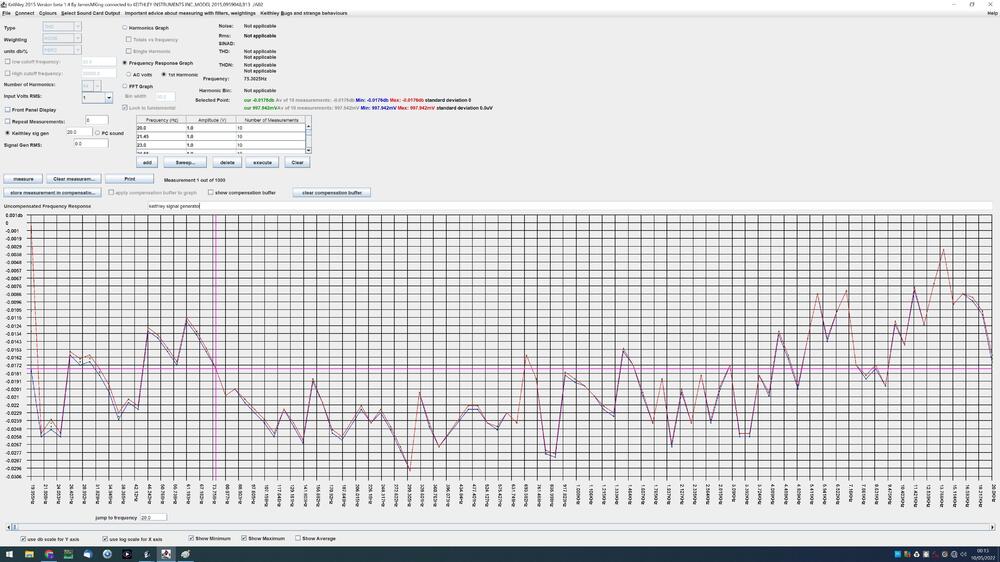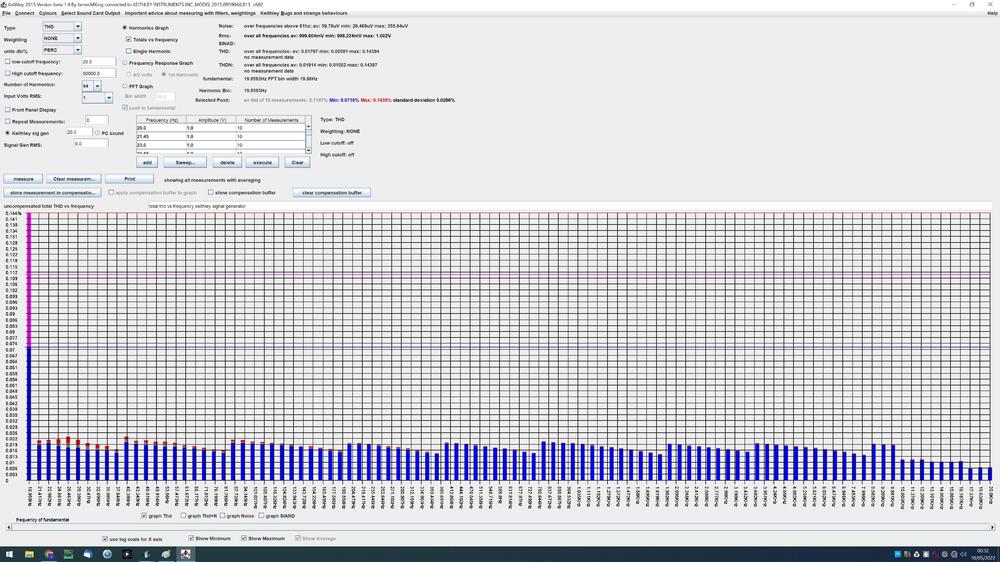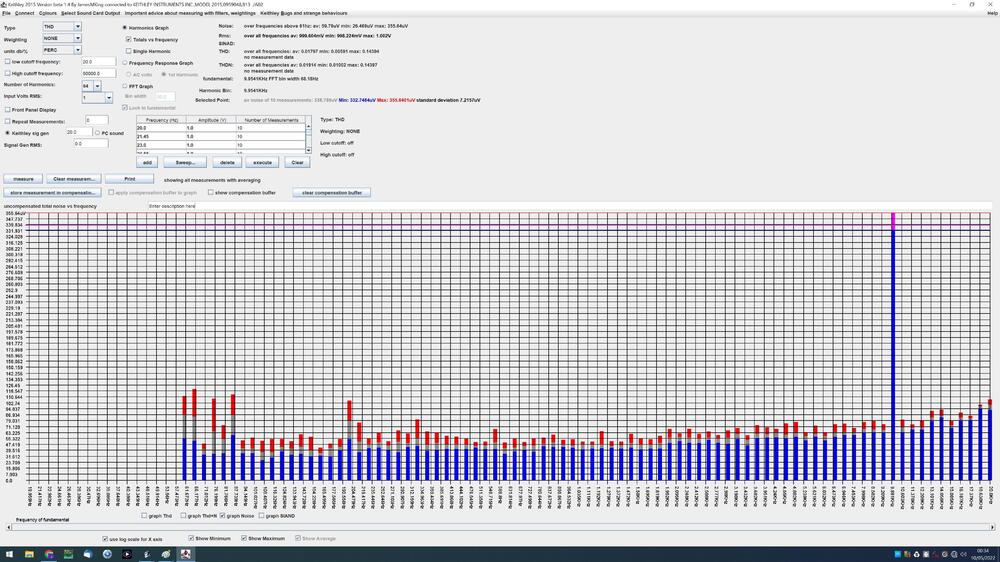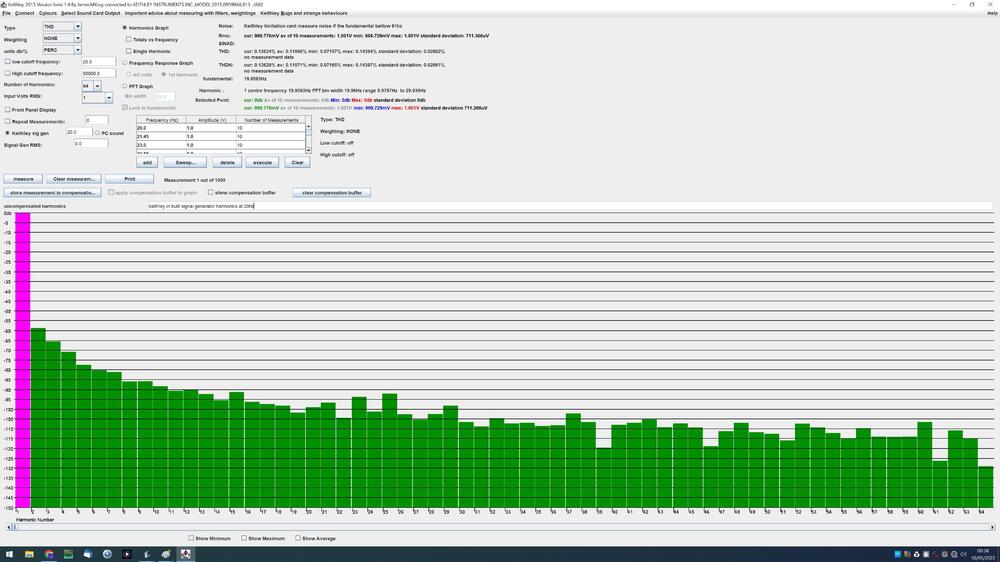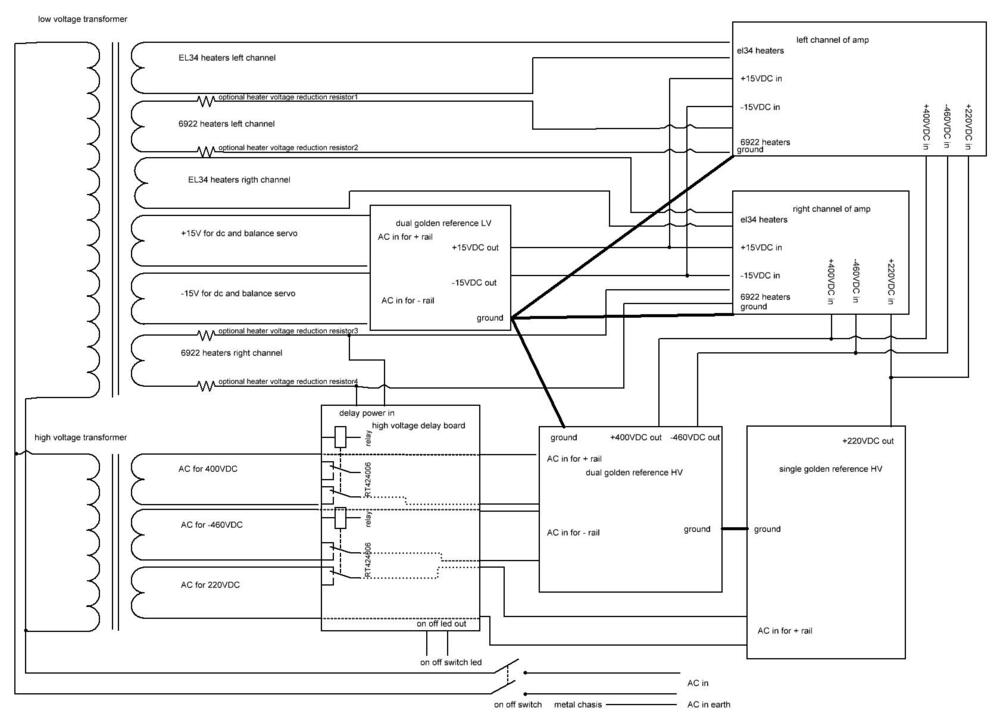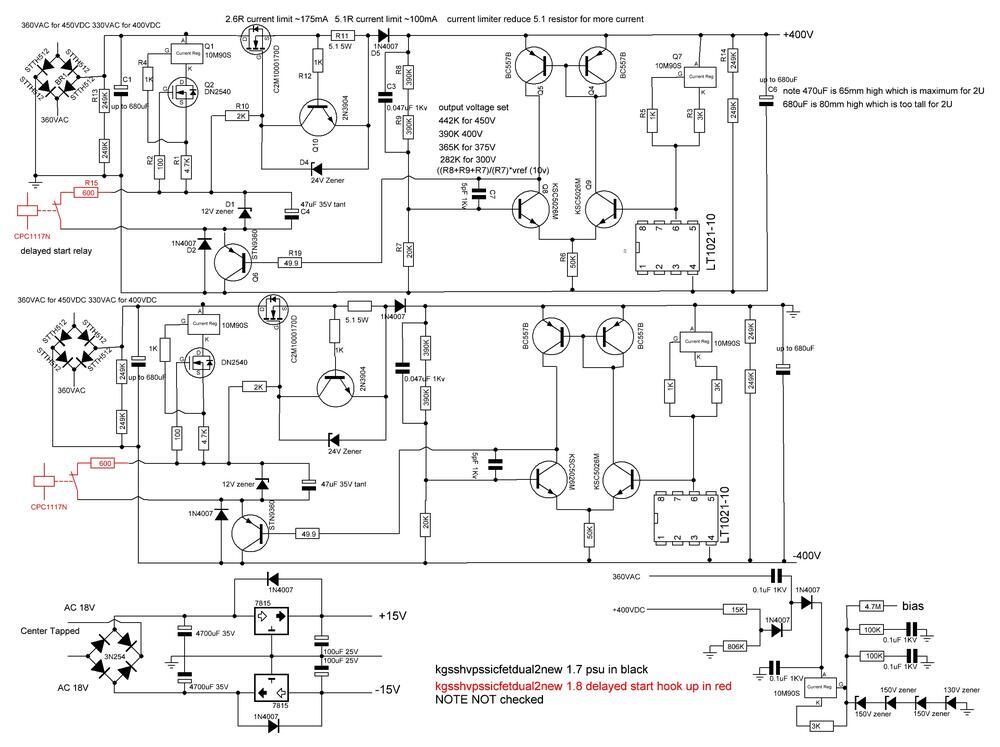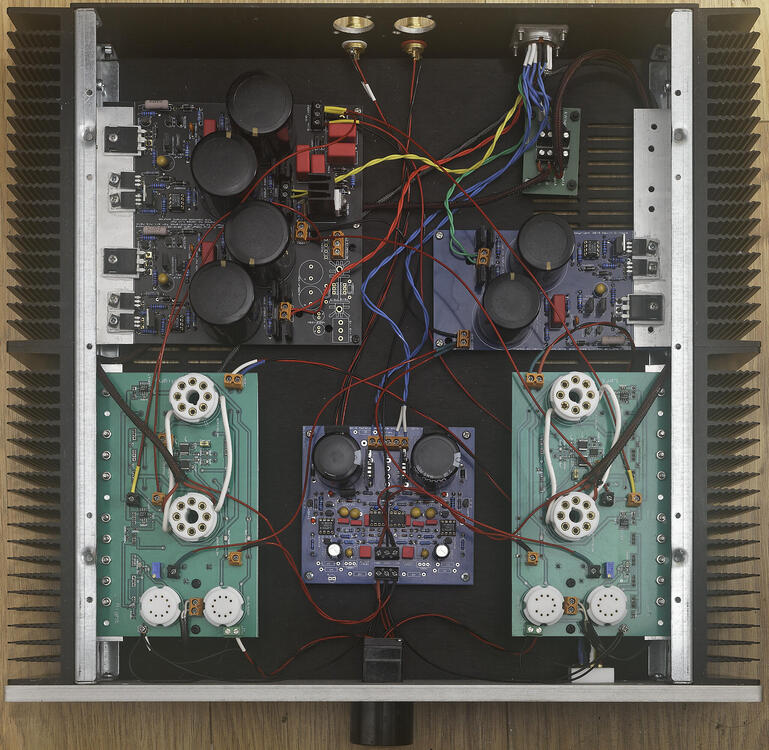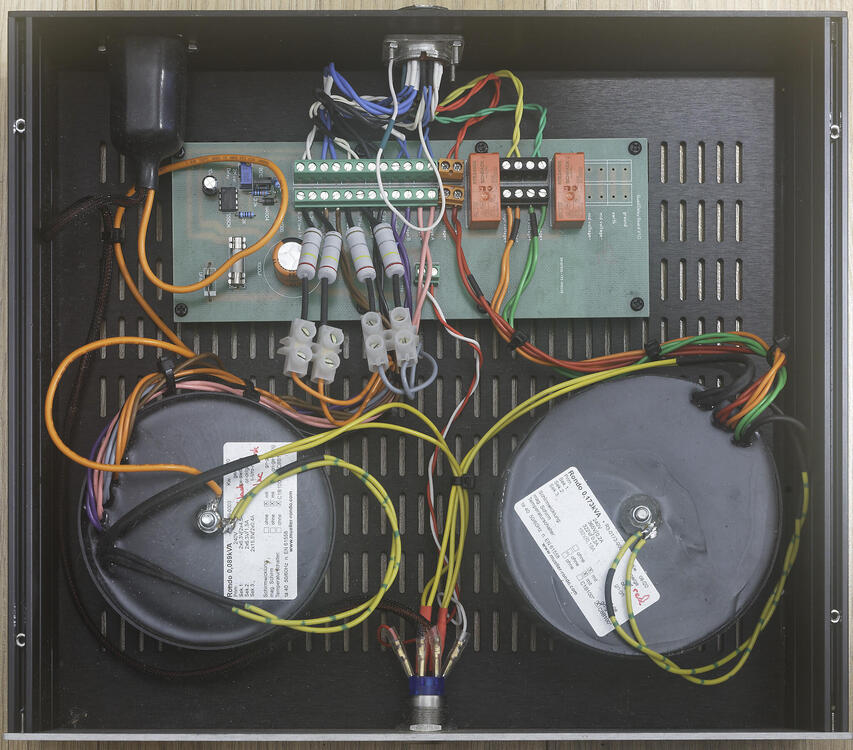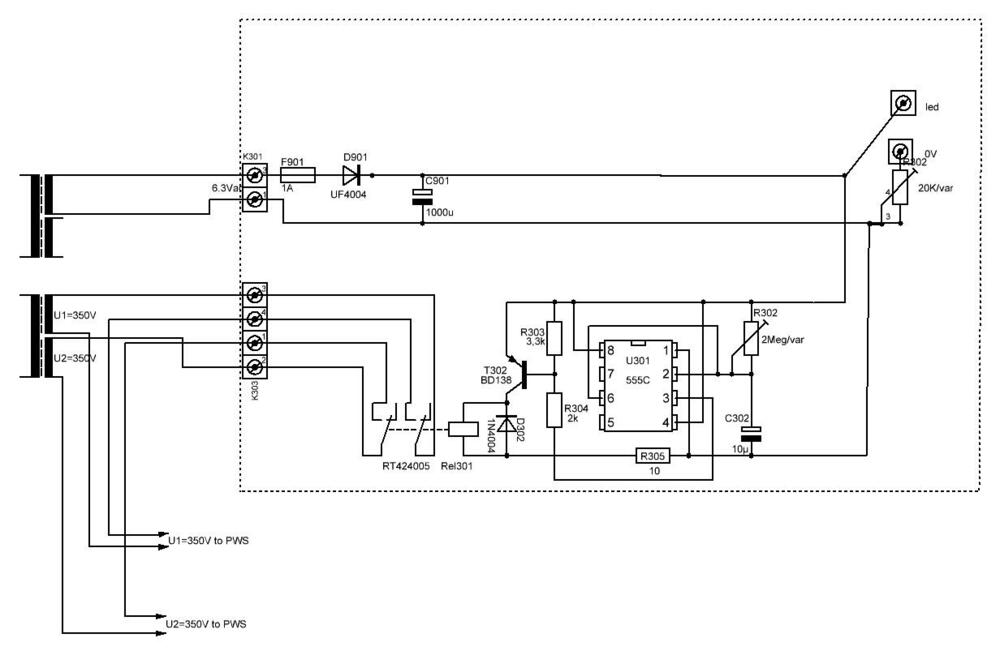
jamesmking
High Rollers-
Posts
406 -
Joined
-
Last visited
-
Days Won
1
Content Type
Profiles
Forums
Events
Everything posted by jamesmking
-
I wonder if it would then be possible to use the redundant quad esl audio step up transfers in reverse to step down the 4cx250 output voltage so it can drive conventional headphones and/or conventional speakers making the amp totally universal: drives quad esl, drives stax without the step down transformer, drives conventional headphones or speakers with transformer.... drives everything SPLAT
-
maybe it can direct drive Quad electrostatic speakers bypassing the speakers in built audio step up transformer 🙂 Kevin, maybe we need a super high current and super high voltage golden reference psu?
-
This is a very niche topic so if you are not planning to buy or write programs for the Keithley 2015 or 2016 thd or p multi-meters then this post will probably not be interesting to you - especially given their skyrocketing prices on ebay and their age. If you are planning to buy one because it has audio analysis built in then there are a number of limitations and issues you should be aware of before deciding to buy. Some of these limitations effect the accuracy and validity of its calculations and are not documented in the manual, some of the limitations effect usability and some effect it programmatically if you access it through gpib or rs232. If you look on the internet there is very little software written for these meters and you may be wondering why. Well now I have written some software for them I think I have a better idea... Here is an example of the "quality" of the manual "The Model 2015/2015-P/2016 can use up to the 64th harmonic of a signal (64 times the fundamental frequency) in the THD measurement, but only recognizes frequencies below 50kHz. Harmonics with frequencies above 50kHz are ignored, therefore acting as an adjustable lowpass filter." What do you mean by use? are the ignored harmonics included in the background noise measurement? or are they simply ignored completely? Well it turns out thd+n included the harmonics as does SINAD. ( I'm still trying to determine for background noise since my calculations do not match the Keithleys). Similarly the statement about the upper frequency is ambiguous for multiple reasons. Bellow 50khz is included and above 50khz is ignored... what about exactly 50khz? more importantly what about a harmonic bin that starts before 50khz but ends after 50khz? or has its centre frequency at 50khz? The 50Khz limit is NOT adjustable and is absolute. There is a separate low pass filter which is configurable and can be switched on and off. Once you dig into the detail the descriptions in the manual leave more questions unanswered than answered. Limitations the in built signal generator goes from 10hz to 20khz only and is flat to within only 0.02db it also has a noise spike at 10khz average noise is about 50uV noise spike is more than 350uV.... thd measurement is limited to a maximum of 64 harmonics. This means if you are measuring the thd a 20hz input, the bandwidth of the thd measurement tops out at 20hz*64 harmonics i.e. way bellow 5khz.. However, Sinad and thd+n not limited to 64 harmonics.... this is obviously inconsistent behaviour and if the harmonics higher than the 64th are large in magnitude then the thd will be underestimated but the sinad and thd+n will be good... it is possible to limit the number of harmonics calculated in the thd to less than 64 using the front panel or programmatically but this does not effect sinad or thd+n calculations. But if you do limit the harmonics and then programmatically ask for all the harmonics any above the limit are not returned - they are lost forever. thd cannot be measured for inputs bellow 20hz or above 20khz all audio analysis is bandwidth limited to 50khz or lower (in some cases the bandwidth limit is 20khz due to the limited number of fft bins) and it is not possible to get the actual bandwidth limit via the front panel or programmatically. If you want to know the upper limit you have to reverse engineer its behaviour - the behaviour is not documented. The fft and harmonics are bandwidth limited to 50khz so if you measure a 20khz fundamental thd is calculated on two harmonics only and one of them is the fundamental! the fft bin width automatically varies depending upon the input signal fundamental frequency for example at 20hz the bin width is 20hz at 1Khz the bin width is 66.6 recurring hz this is not documented and must be reverse engineered to workout the relationship between fundamental frequency and bin width. This is made more difficult when: it is NOT possible to get the bin width displayed on the screen of the keithley or get the bin width programmatically. it is not possible to get the starting or ending frequency of a bin it is not possible to get the number of fft bins used in the thd, thd+n, sinad or noise calculations it is totally unclear from the manual if the rms value for the signal returned in audio analysis mode is the rms value of the entire signal, the signal plus harmonics or just the first harmonic. The manual simply says the result will be different from measuring the ac volts value of the input... Extensive experiments seem to indicate it is the rms of the 1st harmonic. The slowest part of a program communicating with the Keithley is transferring the fft bins especially using rs232. But the keithley does not provide a way for you to obtain the number of fft bins which contain valid data so you have to get all the bins. This increases an fft transfer time by up to 25% (in the case where bandwidth limits the number of valid bins) compared to only fetching the bins with valid data and the situation is far worse if weightings or low and high cut filters are used. you can improve performance across the gpib bus by setting the keithley to transfer floating point numbers rather than number in their text representation however not all measurement returns actually support this so you have special cases all over your program to determine if it should be reading a float or the ascii representation of a float. The manual is also not accurate ascii rather than a float is returned in float mode. If you apply a weighting filter such as C-message which only has a bandwidth from 60hz to 5khz the keithley does not reduce the fft bin width to provide higher FFT resolution. As a result, a 1khz input FFT with C-message results in only 300 valid bins out of 1023 and uses a bin width of 66.66hz when the keithley could have chosen a bin width of 33.33z and doubled the resolution.... or picked a bin width of 20hz and triple the resolution. The weighting filters have brick wall filters attached which is not documented in the programming and user manual. However a promotional document for the keithley does have graphs for the weightings but the actually implemented brick walls are not consistent with the promotional material graphs for CCIR and CCIR/ARM. Experiments show the brick walls are at: CCIT low cut 50hz high cut 5khz CCIR low cut 31.5hz high cut 20khz - this is not consistent with the keithley promotional documentation which shows the weighting graphs and shows CCIR extending to 30khz CCIR/ARM low cut 31.5hz high cut 20khz - this is not consistent with the keithley promotional documentation which shows the weighting graphs and shows CCIR extending to 30khz A weighting low cut 20hz high cut 20khz C message low cut 60hz high cut 5khz It is not possible to get the rms value of a harmonic or fft bin - the only option is to get the result in dbc relative to the first harmonic/fundamental frequency rms value. there is a limit of 1023 fft bins as well as a bandwidth limit of 50khz which means some measurements are only performed on around 735 bins because the bin width is large for example 68hz and more than around 735 bins exceeds the 50khz bandwidth limit - the keithley does not try to minimise the bin width to maximise the resolution and the algorithms used are not documented. As a result at input frequencies bellow 50hz you run out of bins before you reach 50khz and above 50hz you run out of bandwidth and lose bins. The bin width behaviour is very dependant upon the fundamental frequency and so two frequencies close to each other can result in radically different bin widths. you can manually set the bin width BUT if the largest input frequency is not a multiple of the bin width the FFT analysis produces poor results. for input frequencies bellow 61hz the bin width equals the input frequency i.e. all fft bins are harmonics so measuring the noise is impossible since there are no noise bins... However, at least with my firmware, the keithley reports a bogus noise value for frequencies of 60.8 to 61hz even though all bins are fundamantals. there are multiple features which you can only access programmatically: noise measurement (only for input frequencies above 61hz) fft bin values low and high cut filters The keithley has a programmable capture window for acv measurements. A too long window results in slow readings, a too short window results in errors in calculating the frequency of the signal. This capture time is NOT programmable in audio analysis mode and is set to a too short value for low frequencies and results in frequency measurement errors at 20hz to about 30hz resulting in incorrect ffts and high distortion values The signal generator is not particularly low noise or low distortion - about 50uV noise at 1V output and about 0.02% distortion (1khz 64 harmonics). My pc sound card analogue output managed almost an order or magnitude lower distortion when measured by the keithley. The programming manual is misleading and varies in quality and detail from section to section. For example equations are provided for thd, thd+n and sinad but not for its noise calculation or its weightings e.g. A, C-message, CCITT etc. Nowhere does the manual mention fft bin width or number of bins varies with fundamental frequency or provide the equations to work out the number of fft bins or fft bin width for a given fundamental frequency - and reverse engineering this was complicated the algorithm changes 3 times over the frequency range 20 to 20khz... For thd, thd+n and sinad I implemented the equations in the user/programming manual and came up with identical answers to the keithley to around 8 significant digits - the rest being rounding errors. For noise I assume all valid non harmonic bins are noise but my calculations do not match the Keithley... I get around a 1% underestimate so the keithley is finding extra noise from somewhere! But my thd and thd+n calculations match the keithley. If I calculate THD+n - thd should just be the noise and this matches the value I get from calculating on all valid bins minus the harmonic bins and still does not match the keithley. If the keithley was finding noise from somewhere then my thd+n calculation should not match the keithley. I.e. the keithleys (thd+n - thd) and noise calculations are not consistent with each other. Sinad also takes into account noise and again my sinad calculations match the keithleys. The keithley has built in averaging but can only apply this to the thd measurement and NOT noise, sinad, thd+n, fft or harmonic measurements. The keithley uses the SAME command to inform it of the fundamental frequency as it does to set the fft bin width (if you choose to hardwire the binwidth)! This has the effect that if you hardwire the bin width the keithley thinks that value is also the value of the fundamental frequency! it is also not possible on screen or programmatically after the fact to separately get and disambiguate the set hard wired bin width from the fundamental frequency - again the same command is used to get both! if a low or high cut filter cut off frequency is part way into an fft bin the fft ban is not excluded. This is not documented. However possibly my biggest issues with the keithley is that it appears that it does not store raw measurement values and then apply filters, weightings sinad, thd thd+n calculations. Instead it stores the final processed values so there is no way to undo a setting or examine how a setting effects the result. For example if you set a low or high cut filter this effects all calculations. Harmonic bins and fft bins excluded by the filters are lost forever and can not be recovered... changing absolutely any setting invalidates the current reading and requires a new measurement to be taken! i.e. you cant change the weighting filter, cant change the low or high cut filters, can't change the measurement type from thd+n to sinad or vice versa, can't change the number of harmonics included in the thd calculation can't even change the returned thd and thd+n values from db to percent or visa versa. Absolutely any setting change results in you needing to make a new reading. To summarise The signal generator is poor, audio analysis is difficult to control, difficult to understand how it works under the hood, has multiple low frequency measurement limitations, only saves processed values is missing multiple commands for getting useful information about fft bins and has poor documentation on the detailed workings and interactions between settings - especially when multiple settings effect a calculation. Conclusion The keithley hardware is not an audio percision on the cheap. I don't know if any of this will ever be useful to anyone, but I have said it now - perhaps this is more or a rant because of the amount of time and effort I have had to go through to reverse engineer its behaviour and algorithms. If you are insane enough to want to write program(s) for the Keithley I can provide you code for calculating the bin width vs fundamental frequency, number of expected valid bins returned vs fundamental frequency, etc. P.S. AC current limitations the 2015 and 2016 also only have two ac amps ranges 1A and 3A so they are not great choices for low current ac measurement. In contrast the older and more humble keithley 197a has a AC current ranges from 200uA to 10A! here is the frequency response of the keithley signal generator100 frequencies log sweep 10 measurements per frequency. notice at 20hz the standard deviation is almost 1mv on a 1v output and varies by 0.015db over the 10 readings . This is not the signal generators fault - it is a issue with the way the keithley measures frequencies bellow 30hz in audio analysis mode. If you measure in ac volts mode almost all of this variation is gone here is the total thd vs frequency for the inbuilt signal generator. Again notice the disproportionally high thd at 20hz (10 times that of 1khz) and large variations in the 10 measurements min reading at 20hz 0.07% max at 20hz 0.14% at that frequency: The+n looks simular and other signal generators feed in to the keithley also show high 20hz thd and thd+n results. and the harmonic analysis of the 20hz measurement: and the noise vs frequency with the 10khz noise spike:
-
- 5
-

-
stax headphones are naturally balanced. There are two grids that high voltage audio is sent to. Between the grids there is a very thin statically charged sheet. To make the sheet move correctly one grid most have the opposite audio to the other so that one grid attracts the sheet while the other repels. If only one grid had audio (single ended output) the electric field created by the grid would drop off with square of the distance from the grid. So when the sheet is repelled it would move further away from the grid and be less effected by the voltage on the grid resulting in a loss of linearity. With two grids opposing each other the effect of moving away from one grid is directly counter-balanced by the effect of sheet moving closer to the other grid as well as creating a much more uniform electric field between the two grids. Thus maintaining linearity and improves efficiency - the same effect happens in electrostatic loudspeakers. So to drive the stax properly you need a balanced output. there are of course other advantages to balanced such a greater immunity to noise, longer permissible cable lengths, common mode noise cancellation etc etc. for the input to the Stax amp you can use single ended or balanced, however the single ended has to be converted to balanced at some point... disadvantage to balanced you need twice the amp components (excluding power supply which is usually shared between + and - halves of a channel)- if the amp balanced all the way through and probably a phase splitter to provide support for single ended inputs to the amp.
-
the main reasons for an external supply are 1. you are worried about induced hum from the transformer(s) 2. you simply can't fit the power supply in the same case as the amp It is perfectly possible to build a complete blue hawaii with golden reference power supply boards, shielded transformer, high voltage delay etc into a single 400mm deep case saving money over buying two cases and the fiddle of creating a cable run between the psu and amp... I did this in my build. building an amp (if you have the skills, time and test equipment) is considerably cheaper than buying one pre made...
-
drive for the sr007a mk2. I'm sorry I cant comment of the x9000s but if they have simular drive requirements to the sr007mk2 then they are going to sound awful with an underpowered energizer.... I ran the sr007mk2 (very power hungry) on srm006t mk2 - (one weak 6cg7 per channel) and the result was awful, muddy bass that did not get louder as you increased the volume - it just got even more muddy and indistinct. No bass detail no bass extension, poor macro and micro dynamics overall a very unsatisfying sound experience with jazz and classical music. Soundstage lacked air and it was impossible to tell what magic the sr007 would provide when driven properly. Tube rolling did little to help since the problem was lack of drive and all the same design tubes had approximately the same drive. I could effect the treble changing tubes but the bass changed very little. Trying to "improve" the bass elsewhere did not work because the underpowered energizer just could not deliver the bass to the earspeaker anyway. In going to something with 2 EL34s per channel, fully regulated power supplies and constant current anode/cathode sink and sources like the T2 is necessary to get the best out of the 007s and is revelation in sound quality. regards James
-
High-Amp Antares amplifier for electrostatic headphones
jamesmking replied to Zoide's topic in Headphone Amplification
I am afraid don't have any experience of the T1s, or ecc99. Constant current is going to help the T1S. My guess would be that the high amp psu is better but in the forum people have reported considerable sound quality upgrades moving from resistor load to CC so the T1s with CC would probably be better than the Antares. T1 with CC vs Centauri (centauri is two 6sn7 per channel so more current potential and runs high voltages too) so more difficult to predict a winner. (some of the other forum members like spritzer have massive amounts of experience and would almost certainly be able to provide more solid info than I can from guesswork). some of the choice is going to be down to what you want the amp for... do you want something pre made and plug and play, or do you want to modify an existing T1s or do you want to have a go at building something fairly simple from scratch, plus it depends on your budget. -
High-Amp Antares amplifier for electrostatic headphones
jamesmking replied to Zoide's topic in Headphone Amplification
I have not tried the Antares, but I did build an alpha Centauri... which was my first even stax amp build. All of the high-amp designs are similar in that they use resistors for the anode load rather than a constant current source and have relatively limited voltage swings. The high voltage power supplies are ok - they don't use a precision voltage reference like the golden reference series but they are better than the supplies found in most(all?) of staxes offerings and they have very good short circuit protection and robustness. The headphones bias is regulated (unlike most/(all?) of staxes offerings) and correctly has a ~5Meg ohm current limit resistor and is the correct 580Voltage too. Overall I would say the designs are competent but certainly not for state of the art. I did find a few errors in the schematic and gerbers for the Centauri but the designer was very helpful and I got the amp working with minimal pcb hacks. My issue with the centauri and antares is that the 6sn7 does not have a lot of current drive or voltage swing compared to the EL34 which is favoured in Kevnis value designs and coupled with a resistor network instead of a constant current source you lose even more drive so its going to struggle with hard to drive headphones like the sr007a... looking at Antares its a single value version of the centauri with lower voltages, so less drive than the centauri. Front end looks very similar, if not identical to the Centauri. I found the centauri to the better than the Stax srm006mk2 - more drive, better bass and dynamics but still nothing close to a blue hawaii, mini T2 or a T2. looking at the specs its got a fairly wide frequency response with not a lot of low frequency cut off - which is typical for dc coupled amps. Distortion is high for 300V swing - but that's to be expected given the low drive voltages and a single 5sn7 per channel. So if you want a relatively robust and simple to build starter project the Antares might be an option. If you want a replacement for a srm006 it might be better given the better power supply. If you want high end sound on a budget you are not going to get it from this amp. -
goldenreference high voltage power supply (GRHV)
jamesmking replied to Pars's topic in Do It Yourself
all the golden reference I have built (both low and high voltage) produce the expected output with no load. (unlike some 78 or 79 series voltage regulators) if you build the smd versions of the golden e.g. the gr78xx they are not stable until you have output caps as well. 16R load is way way to low resistance for anything except fireworks/smoke.... to make the maths easy say the HV is 160V and 16R. V/R = I so thats 160V/16R = 10A... NO way a GR hv is going to provide that and if it could.... power = I * V = 10A * 160V = 1600W..... or 1.6KW... thats going to be one BIG load resistor.... the figures will be worse with even higher voltages e.g. 450V 1.6K resistor would give you 160V/1600R = 0.1A and 16W which is still a fairly big resistor at 160V output.... 16K seems more reasonable for higher voltages than that.... for the gr lv, assuming 16V output and the same 16ohm resistor, you would still pull 1A and get 16W... and worse at higher voltages.... For testing the LV I use a electronic DC load I never power up newly built power supplies without using a variac to give me at least some indication of issues at lower voltages. you could temporarily put a resistor in parallel over the voltage setting resistor(s) to reduce the output voltage to more "safe levels" e.g. say 50V output on the grhv. (variac recommended to you don't get too much voltage drop and therefore heat in the pre regulation stages and across the pass mosfet). -
ideally there should be no dc offset. However without an active offset servo, offset will change as the valves\transistors age and as they warm up and is to be expected. The headphones can take hundreds of volts of audio input without damage and have a very high input impedance so an offset of 10VDC or so is not a big issue since it represents a negligible current flow, will not cause any arcing and will not damage the headphones.
-
Everyone has their own tastes in sound. In my experience the manufacturer of the valves can radically change the sound of stax valve amps. I mostly listen to classical and jazz and want a warm detailed sound. I am very intolerant of hard bright metallic treble. I like dynamics - both micro and macro and am fairly tolerant of sound stage width, depth and imaging. I listen to many historic recordings and I don't like overly analytical sound balances that rip apart old recordings... but everyone has their own priorities and listening preferences.. So please don't spend money on 6922s just based on my experiences. I tried gold pin electro harmonix 6922. They sounded ok but I had one go noisy and the two triode halves on almost everyone of the 12 I purchased were very miss matched (the seller did not offer matched triodes) and they almost all tested very weak <50% on my avo IV valve tester and they quickly got weaker with use. I don't know if I hot a bad batch but the online shop only offered a 3 month warrantee. I have not tried buying any from another shop, until proven otherwise I consider them an unreliable waste of money. I wonder if they are actually 6922s and not something else. I tried some NOS philips e88cc - tested much stronger and better balanced triodes but I found them to not have a lot of bass and somewhat bright for my setup. At the moment I am using genalex gold lion 6922. Fairly well matched triodes and all tested close to 100% on the avo. They are quite dynamic and have good deep bass the treble is extended, but they are not cheap. for EL34s I tried electro harmonics - awful, transistor sounding hard bright metallic and ran very hot. cheap and useful for testing on initial start-up but not for listening. I tried grove tubes EL34s these sounded ok but the price recently went up by 25% turning them from a cheap bargain to more expensive then most other non nos options. currently I am running tung-sol el34s. In the uk they are cheaper than the groove tubes and have deeper better bass, more dynamics and imaging. However I did have one fail - the anode sparked fortunately no damage was done to the diy T2. Again the uk shop only offered a 3 month warrantee and the failure was after 3 months and two weeks... I now buy all my valves from partsconnexion - which even without sale prices and with fast including shipping it is still cheaper than buying in the uk, they offer 6 month warrantee and often have 20% off sales.... many transistors required for stax amp builds have been out of stock for 6 months or more and probably will be out of stock for another 6 months to a year.. its the great transistor and semiconductor shortage.... you just have to be patient or perhaps someone on the forum has spares they could sell you.
-
two chips?? do you mean the op-amps on the amplifier boards - they are for the dc servo and balance servo. The heaters will pull more current when you first switch on since the heaters resistance will be lowest when they are cold. As the heaters heat up the resistance of the heaters goes up and so they draw less current until they reach a stable current draw. or do you mean the chips on the golden reference low and high voltage boards? they are 10V high quality voltage references used as part of the voltage regulation and control circuits. The opamps on the golden reference lv boards are used to compare the voltage reference against the output voltage (divided down by a set of series resistors) and adjusts the output voltage accordingly. the other chips on the amplifier boards are also voltage references (the same as in the golden reference lv and hv boards) and are they are used to control the constant current anode/plate supplies to the el34s. The final chip on the amp boards is an opto coupler to provide high voltage isolation between the el34s and the Dc offset servo.
-
I run the heaters at about 6VAC which can increase the life of the valves. I have resistors on the 6922 heater transformer outputs because the transformers where outputting about 6.6VAC which is too much. (You need separate transformer windings for the 6.3VAC heaters on the el34s in each channel and separate from the 6922s heaters. The el34s have their heaters at about at about -400V.) The EL34s draw far more current and the voltages without any dropper resistors are about 6VAC for the transformers I purchased. On switch on all valves are provided with heater voltages simultaneously from the low voltage transformer and the opamp dc balance and dc offset servos are powered on from the +-15V golden reference lv or simple lv in the golden reference hv board. Only the high voltages are delayed in order to allow the valves cathodes to heat up and develop a space charge before the high voltages are activated. I use a one minute delay. All other voltages pass through the delay board without being switched or delayed. Here is a simplified block diagram for the wiring I used (there are other ways of doing this).
-
+400 and -460 come from the dual golden reference board, +220V comes from the single golden reference board. look at the amp photo above the dual golden reference is the large square black pcb, the 220V golden reference is on the right hand side of that the blue long slim pcb. The high voltage transformer provides 3 windings, one for each of the high voltage outputs. One wire from each of the high voltage windings is switched by the long thin green delay board in the psu case. if you look at the right hand side transformer that is the high voltage transformer. the colour coding on the transformer wires was green for the 220VDC supply, yellow/orange for the 400V dc supply and red for the 460V supply. To set the outputs of a golden reference hv board you need to change 2 resistors for each output. check the golden reference hv thread for more details. (The 580V bias supply for the headphones is generated from the plus 400V supply.)
-
there are many possibilities: for the power supplies first you need to decide if you want to heat the valves up before you apply high voltage. If you do then there are two options. Do you want to implement the delay using a relay (and either switching the ac input to the high voltage transformer or dc output of the high voltage psus) or apply a dc voltage to switch on the high voltage psus? IF you do not want high voltage delay or want to do the entire delay e.g. by timed relay off the psu board then use the golden reference 1.7 series psus if you want to switch on the hv psu by providing timed dc then use the golden reference 1.8 boards. next you need 3 hv rails - two positive (220V and 400V) and one negative (-460V). So you need to look at the options. golden reference Dual boards have a positive and negative rail, headphones bias and a simple low voltages + and - rail on one pcb but are of course wider than a single rail board. or you could go for three single rail separate golden reference boards. boards with left in their name have a negative rail and simple low voltage supplies. boards with right in their name have a positive hv rail and the 580V headphones bias. See https://www.head-case.org/forums/topic/15634-goldenreference-high-voltage-power-supply-grhv/#comment-851207 for board physical sizes. Next for an over kill design you may want to have a high performance low voltage section using a golden reference LV board instead of the basic low voltage section provided on the golden reference hv boards. The low voltage provides power to the dc servo, balance servo and cathodes of the 6922s that the input signal goes into for the delay board you can use https://drive.google.com/drive/folders/1r3g2TAtBUaBdiMorTWX7yYgeJ7maQbYW or use what I use which is taken from a German website: schematic: http://www.high-amp.de/html/reg_pws_v3_add_on_schematics.html gerbers etc http://www.high-amp.de/powersupply_stabil_add_on.rar NOTE the hi amp delay board also provides a dc 6.3V supply capable of powering the 6922s but then requires 2 windings of about 8VAC rms as its input. Or you can just not implement the circuit for the 6Vdc heater supply and run the delay timer and relay off a single 6.6VAC winding without issue - which is what I do (see bellow). If you only implement the delay from the high amp board this is the schematic of what you need: Here is my build with a golden reference HV 1.7 dual and golden reference 1.7 right (modified by me to remove the bias components), and a golden reference lv (the delay board is in the psu box with transformers.). The delay board I designed myself based upon the delay circuit from high-amp. It runs off one of the 6922 heaters and is modified so it switches all three outputs of the HV transformer - which is why there are two relays. It also provides screw terminals so you can attach dropper resistors if your heater voltages are two high. (I like to run the heaters 6922s at 6VAC rms). The delay board I made also provides dc power for the led in the on off switch. Removing the fuse allows you to power up the heaters and low voltages only. The standard hi amp delay board only provides a single relay which can be used to switch the AC input to the high voltage transformer. This mandates the use of two transformers - one for the low voltages, heaters and delay board power and a separate one for the high voltages. My board switches the outputs of the HV transformer and so could be used with a single transformer setup or dual transformers. It also provides terminals for all voltages going to the amp. (I have a build policy that all pcbs and major components e.g. transformers should be removable for servicing with zero disordering - hence the screw terminals added to the delay board.) here is the gerbers for my dual relay pcb with screw terminals: mini t2 delay with screw terminals.zip here are the gerbers for the dual delay with no extra screw terminals for the other voltages: mini t2 dual relay delay no screw terminals.zip
-
Megatron Electrostatic Headphone Amplifier
jamesmking replied to kevin gilmore's topic in Do It Yourself
nicely megafixed (tm) 🙂 -
on semi are end of life/obsoleting the FQPF8N80C https://www.mouser.co.uk/ProductDetail/onsemi-Fairchild/FQPF8N80C?qs=oLpdVludopqPPn1yJbx16Q%3D%3D its used in the power supplies for the T2 (kgsshv) and the modern version of the blue Hawaii. thank you again onsemi for obsoleting everything that is high voltage and/or audio related. currently radio spares and digikey have stock mouser has been out of stock for some time. EDIT: As Kerry has pointed out only mouser is showing this as End Of Life so hopefully this is not the case.
-
I use the mostly modern T2 with 10K (and also the mini T2, blue hawaii and megatron)
-
cool, I guess thats why the grhv on the side wall does not have the output connected to anything. dont forget the two separate grhv boards will also need a common ground with everything else.... since the grlv has two ground terminals, it can make a convenient centre point for the grounds: GRLV--ground -----------amp Left ground | | | | | +-------------amp right ground | +----------------one GRHV ground +---------- other grhv ground (the two rails of the grlv already share a common ground on the grlv pcb)
-
can I ask a possibly dumb question, I see the grlv with fully populated + and - sections, the board attached to the side wall seems to be a grhv but it only looks like a single rail grhv which would mean its either +400V or -400V but not both! it does not look like a dual output grhv board to me..... I also cant see a bias supply. Or do you have another single rail grhv with the bias hiding somewhere else???? I also don't see the outputs of the single channel grhv being connected to anything...
-
his grlv seems to have separate windings for + and - (and they are using two diode bridges in the lv) and I don't think the grhv offers a centre tapped option at all - all the grhv I have seen have separate diode bridges for + and -
-
star ground just makes sure the grounds don't for a loop for my builds my grounds go GRHV --ground -----------amp Left ground | | | +-------------amp right ground +----------------GRLV ground you can of course swap the grhv and grlv in the above and it will still work the same. The makes one psu the master for ground reference and everything else is in a tree from that with zero loops. A longer tree will also work e.g. GRHV --ground ----------- GRLV ground ---------------- amp Left ground | +-------------amp right ground so everything has a ground wire from one psu board and no loops. What may cause hum is ground loops. For example if both the grlv and hv are ground connected together and you also run grounds from both the grlv and grhv to both amp boards. You now have multiple return paths. e.g. +15V can go directly to grlv or can go grhv -> grlv and visa versa for the high voltages. In addition +15V on left channel could go grhv -> right channel -> grlv or even worse left channel +15V could go grhv -> right channel -> left channel -> grlv etc etc... i.e. multiple ground loops: GRHV --ground -----------amp Left ground---------+-----+ | | | | + -----------amp right ground ------- + | | | | +----------------GRLV ground --------------+-----+
-
since the grlv and grhv have separate transformer windings they are floating with respect to each other. with only one amp being grounded through the grhv that amp board is tied to that psu but would have no idea what the LV voltage is since the LV floating with respect to the hv psu and not referenced to it. The other amp board being grounded through the LV only would have no idea what the hv voltage is in relation to the lv voltage.... you would see this by measuring the voltages on one amp board with the multimeter neg on that amps ground and then measure the voltages on the that amp board with the multimeter neg on that amp boards ground. Another way to think of it is electricity flows in a circle, for the amp connected to the hv board the electricity comes out of the hv board goes into the amp board and returns to the hv board through the ground wire, The Lv electricity enters the amp board BUT has no return path direct or indirect to the LV board... and visa versa for the amp board connected to the lv ground only.... This is why I check the psu voltages of a fully built amp at the amp board using the amp boards ground and not at the psu using the psu ground....
-
I would suggest 0. make sure there is continuity between the grounds on the amp boards, hv psu and low voltage psu. HV psu ground -> amp ground LV psu ground to -> another amp board with no ground connection between the LV and HV boards is not going to work. All 4 pcbs needs to share a common ground. 1. check nothing is shorting to the case on the amp boards e.g. metal tabs on transistors 2. check the amp boards for solder bridges. 3. did you check each transistor before soldering in? did you get the transistors from known reliable sources? i.e. could any of the transistors be fake? 4. did you see any burn marks on the amp pcbs, discoloured components etc. 5. check the orientation of transistors, diodes, zeners. 6. try each channel powered up separately - to see if you can isolate the problem to a single channel or if its both channels and quickly measure the psu voltages on the amp board. Whichever rail has a short will almost certainly show much lower voltage than expected... This might narrow it down to one channel and or a particular voltage rail. 7. power up the amp boards with just the low voltages to see if its a short in the low voltage part of the amp boards. 9 post some detailed photos
-
I agree a variac is not a substitute for a dim blub tester. I use a variac because if something is going to go wrong I would rather it go wrong at lower voltages than full to limit the damage.

